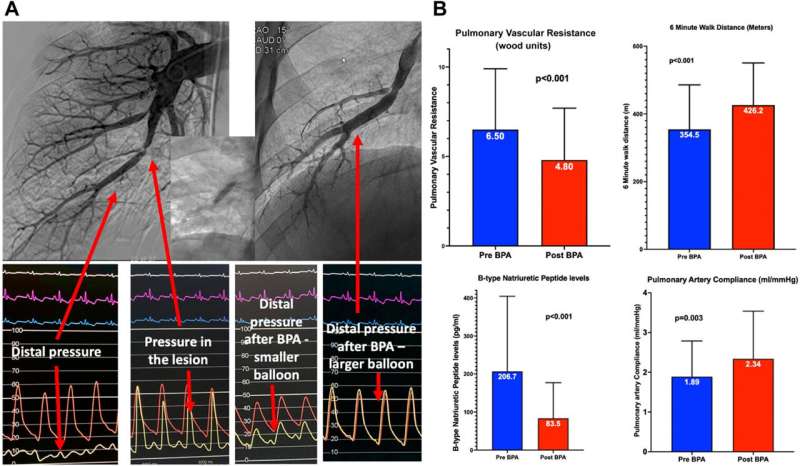This article has been reviewed according to Science X's editorial process and policies. Editors have highlighted the following attributes while ensuring the content's credibility:
fact-checked
trusted source
proofread
Balloon pulmonary angioplasty, a novel treatment for chronic blood clots in lung arteries

Old blood clots in lung arteries can obstruct blood flow and lead to pressure build-up in the affected arteries. When this happens, symptoms such as shortness of breath, fatigue, chest pain, and fainting spells may develop, which severely impair quality of life. While this condition, known as chronic thromboembolic pulmonary hypertension (CTEPH), is often effectively treated with open heart surgery, many CTEPH patients cannot undergo surgery, because of other medical problems or because blockages in their arteries are beyond the reach of surgery.
Now, a new study by researchers at the Lewis Katz School of Medicine at Temple University shows that a novel treatment approach known as balloon pulmonary angioplasty can be effective for treating CTEPH patients who are not able to undergo surgery. The study, carried out at Temple Heart & Vascular Institute's Pulmonary Hypertension, Right Heart Failure and CTEPH Program, is one of the largest investigations of balloon pulmonary angioplasty in the United States to date. The findings appeared online in the journal JACC: Advances.
"Our study showed that opening up blockages in lung arteries of these patients markedly improved exercise capacity and quality of life," said Riyaz Bashir, MD, FACC, Professor of Medicine and Director of Vascular and Endovascular Medicine in the Section of Cardiology, Department of Medicine, at the Lewis Katz School of Medicine and Temple University Hospital, and senior investigator on the new study.
"CTEPH patients treated with balloon pulmonary angioplasty come away having fewer symptoms, and some may be able to come off medications altogether."
Temple is one of the leading centers in the nation in treating CTEPH patients with balloon pulmonary angioplasty. Dr. Bashir, along with Paul Forfia, MD, and Anjali Vaidya, MD, Co-Directors of the Pulmonary Hypertension, Right Heart Failure, and CTEPH Program; Vladimir Lakhter, DO, Assistant Professor of Medicine at the Lewis Katz School of Medicine; and Estefania Oliveros, MD, MSc, Director of Research at the Pulmonary Hypertension, Right Heart Failure, and CTEPH Program, were involved in the treatment and follow-up care of these patients.
Balloon pulmonary angioplasty was first introduced in the early 2000s but was associated with high rates of major complications. Refinements in technique over the past decade have vastly improved its efficacy and safety. The procedure is carried out by putting a small tube in the groin vein.
A long catheter over a wire is advanced through the tube and into the lung arteries, where a blockage is identified under an X-ray camera. A small balloon is then used to open the blockage slowly, while blood pressure beyond the blockage is monitored simultaneously. Patients typically are awake and are given a mild sedative and local anesthesia during the procedure.
In order to open blockages throughout the lungs, balloon pulmonary angioplasty is carried out over the course of multiple treatment sessions. The approach used at the Temple Heart & Vascular Institute is gradual and deliberate, in order to prevent complications, especially bleeding into the lungs.
Bleeding risk traditionally has been high with balloon pulmonary angioplasty. "But with continued refinement of the procedure, we have successfully decreased bleeding rates in these patients," Dr. Bashir explained. "In doing so, we are now able to show that balloon pulmonary angioplasty is not only relatively safe but also associated with key improvements in pulmonary hypertension and functional capacity."
More information: Riyaz Bashir et al, Refined Balloon Pulmonary Angioplasty in Chronic Thromboembolic Pulmonary Hypertension, JACC: Advances (2023). DOI: 10.1016/j.jacadv.2023.100291




















